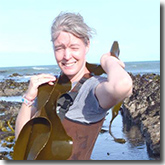In addition to serving as a source of amusing common names, books like Gosse’s “A History of the British Sea Anemones and Corals” can be a source of gorgeous and informative illustrations. The images here all depict the species Gosse called “The Plumose Anemone.” Metridium senile is common on both coasts of the North Atlantic Ocean and has close relatives in temperate Pacific waters (some of these have been called M. senile, but are now recognized as distinct species). The drawings in these five guides highlight several of the key field attributes of the species and manage to convey a sense of the beauty of the animals. Scanned copies of most of these books are available through the “Biodiversity heritage Library.”
“A history of the British sea-anemones and corals” by Philip Henry Gosse (1858)
“A popular history of British zoophytes or corallines” by the Rev. D. Landsborough (1852)
“A Manual of the sea anemones commonly found on the English coast” by the Rev. George Tugwell (1856)
“British Zoophytes” by Arthur S. Pennington (1885)
“The British Sea Anemones” by T. A. Stephenson (1935)
On the plate of Metridium senile from Gosse’s (1858) guide to British anemones and corals note the undulating oral disc, a characteristic of the species. All of the plates in Gosse’s treatise are based on watercolors he made of living specimens.
Landsborough’s (1852) “Popular History of Zoophytes” preceded Gosse’s treatment of sea anemones, corals and their kin. As the plate label shows, at the time this book was published, the accepted name for the species was Actinia dianthus.
Tugwell’s (1856) “Manual of Sea Anemones” also preceded Gosse’s treatise. The frontispiece of this volume includes a fold-out color plate of M. senile that shows both the undulating disc and short tentacles characteristic of this species.
The figure from Pennington’s (1885) “British Zoophytes” strongly recalls Gosse’s plate, suggesting that the latter was inspiration or template for the line drawing upon which this figure is based.
Stephenson’s (1935) guide “The British Sea Anemones” included watercolor-based plates that rival Gosse’s for their beauty and level of scientific detail. This plate shows the color diversity in M. senile and depicts the tentacles from above and the side.
In addition to showing the whole of M. senile, Stephenson (1935) included tentacles of the species (upper R and L corners) in a fanciful but effective compilation intended to highlight differences in arrangement, shape, and coloration of tentacles in the various species of sea anemone in Britain.
About the Author: Dr. Meg Daly is Professor in the department of Evolution, Ecology and Organismal Biology, director of the Museum of Biological Diversity and leads the laboratory of marine invertebrate diversity at OSU. She and her students study systematics of cnidaria, sea anemones, jellyfish and their like.



